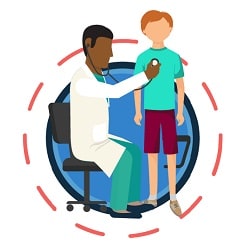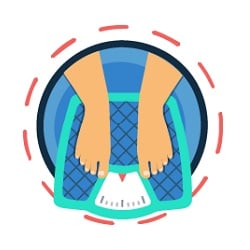Healthy Schools
In the United States, more than 2 in 5 children aged 6 to 17 years have a chronic health condition such as asthma, diabetes, or epilepsy. In addition, an estimated 1 in 5 children aged 6 to 19 years has obesity, and racial and ethnic disparities are common: in 2017–2018, the rate was 25.6% for Hispanic children, 24.2% for Black children, 16.1% for White children, and 8.7% for Asian children.
Unhealthy behaviors and the social determinants of health
Poor nutrition and physical inactivity are more common in children whose families have a hard time being healthy because of conditions where they live and work. These social determinants of health lead to worse health for some people.
A recent study showed that, among high school students:
- Hispanic students eat vegetables less often and drink sports drinks more often than White students.
- Black students miss breakfast more often and get physical activity less often than White students.
Students with unhealthy behaviors or chronic conditions may miss more school, which reduces their time for learning. The result may be lower grades, a higher chance of disability, and fewer job options as they enter adulthood.

An ideal setting to practice healthy behaviors
Developing healthy behaviors during childhood is easier and more effective than trying to change unhealthy behaviors during adulthood. Improving dietary and physical activity behaviors is especially important for students at increased risk of chronic diseases because of their race, ethnicity, or family income level.
Most US children spend 6 to 7 hours a day at school—a large part of their waking hours. This is why schools play a critical role in helping children develop lifelong healthy habits. Each day, 98,000 public schools in the United States provide a setting for 48 million students to learn about health and healthy behaviors.
Fast Stats
In the United States:

2 IN 5 CHILDREN
aged 6 to 17 have a chronic health condition.

20% OF CHILDREN
had obesity in 2017 – March 2020.

4 IN 5 HIGH SCHOOL STUDENTS
don’t get enough sleep.

48 MILLION STUDENTS
could be reached with health messages.
CDC’s Approach
Working With Schools to Make Students Healthier
With $15.4 million in FY 2021 funding, CDC Healthy Schools works with states, school systems, communities, and national partners to prevent chronic diseases and promote the physical and mental health and well-being of students.
The Whole School, Whole Community, Whole Child (WSCC) model is CDC’s framework for improving health in schools. The WSCC model is student-centered and emphasizes the importance of evidence-based policies and practices and the role of the community in supporting schools.
Partnering with key leaders from the health and education fields, CDC Healthy Schools promotes:
- Healthier nutrition options and education.
- Comprehensive physical education and physical activity programs.
- Improved school policies and better staff training to help students manage chronic conditions.
- Health education that instills lifelong healthy habits and health literacy.
- Practices that improve school health services and links to clinical and community resources.
- School employee wellness programs that contribute to students’ health and academic success.
- Strategies that support students’ social and emotional learning and improve the social and emotional climate in schools.
Collecting Data
CDC uses two surveillance systems to monitor health behaviors, practices, and policies in schools: the Youth Risk Behavior Surveillance System and the School Health Profiles.
Data collected by these systems are used to:
- Identify effective strategies.
- Develop and evaluate programs.
- Develop guidelines and tools to improve school health policies, programs, and curricula.
For example, data from the 2019 national Youth Risk Behavior Survey [PDF – 475 KB] show that students with higher grades are more likely to have healthy nutrition habits—such as eating vegetables at least once a day or drinking milk instead of soft drinks—than students with lower grades. School officials and other decision makers can use this information to promote policies and practices that support healthy eating in schools.
Funding Schools and Partners
CDC funds state education agencies to improve the health and academic achievement of students by improving their nutrition and physical activity behaviors.
For example, North Carolina used CDC funds to develop a healthy eating program for several of its school districts. As a result, nearly 8,000 students now have access to drinking water throughout the school day. They are also learning about the nutritional value of foods served in school cafeterias from electronic menu boards.
CDC also funds education agencies to help students prevent and manage chronic health conditions. Asthma, diabetes, epilepsy, food allergies, and poor oral health are common among students.
Training School Staff

CDC provides free resources and training that school administrators and staff can use to help ensure that students are healthy and ready to learn. Many are self-directed e-learning modules that include resource links, videos, and continuing education opportunities. State departments of education, state departments of health, school districts, and national organizations can also use these resources to help schools improve the knowledge and skills of their staff.
Promoting Parent Involvement
CDC provides information and resources to help parents become involved in their child’s school, advocate for their child, and help shape a healthy school environment. Parents can learn what schools are doing to keep children healthy and safe, as well as how they can take action and track progress. These resources can also help schools and school groups—such as parent-teacher organizations and school wellness committees—work with parents to get them involved.
